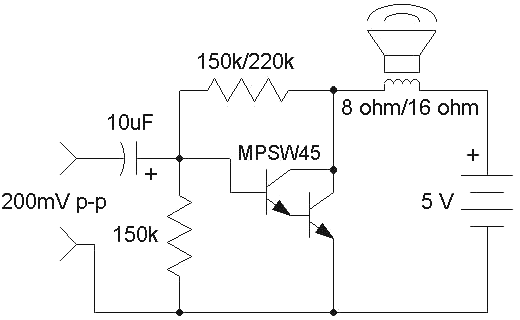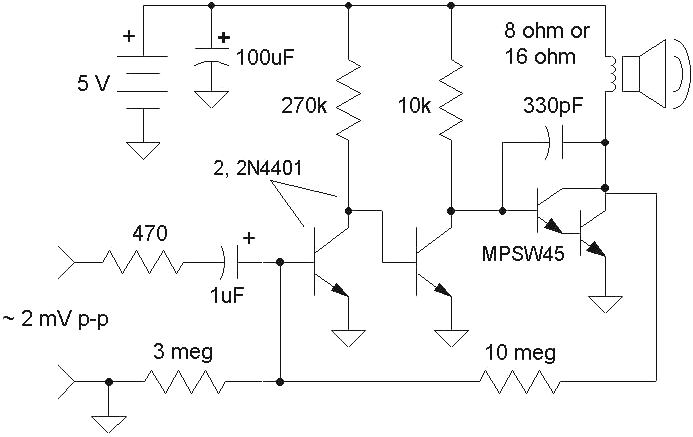Class-A Audio Amplifiers
A class-A audio amplifier is pretty wasteful of power but when plenty of power is available the simplicity is attractive. Here is a simple darlington transistor example intended for use with a 5 volt power supply.
This circuit and the following aren't for beginners; they are of limited usefulness and require an understanding of the underlying principles and potential applications. They all pass DC through the speaker which is wasteful and can cause problems for the inexperienced builder. If built without variation, they should perform as described but make sure to read the text.
The 5 volts should be provided by a regulated power supply. The efficiency is below 25% and significant DC current flows in the speaker and that additional power should be figured in to the power rating of the speaker. But look how simple it is! The voltage gain is only about 20 and the input impedance is about 12k. The schematic shows two values of bias resistor to be used with the corresponding speaker impedance. With the 150k bias resistor and 8 ohm speaker, the circuit draws about 210mA (1 watt) and can deliver about 250 mW to the speaker which is plenty of volume for most small projects. The speaker should be rated at 500 mW or more and should exhibit a DC resistance near 8 ohms (perhaps 7 ohms). Check the candidate speaker with an ohmmeter; much below 7 ohms will cause excessive current draw. With the 220k resistor and 16 ohm speaker, the circuit draws about 100 mA (500 mW) and delivers about 125 mW to the speaker. The 16 ohms speaker should be rated at 200 mW or more and exhibit nearly 16 ohms of DC resistance. (Most small speakers have a DC resistance near the rated impedance and that resistance is used to set the quiescent current level in this circuit.) Other NPN darlington transistors will work but choose one that can dissipate 1 watt minimum. Most power types don't need a heatsink but tiny TO92's might overheat.
If the inefficiency of the class-A hasn't dissuaded you yet, here is a 4-transistor amplifier suitable for small signals:
A class-A audio amplifier is pretty wasteful of power but when plenty of power is available the simplicity is attractive. Here is a simple darlington transistor example intended for use with a 5 volt power supply.
This circuit and the following aren't for beginners; they are of limited usefulness and require an understanding of the underlying principles and potential applications. They all pass DC through the speaker which is wasteful and can cause problems for the inexperienced builder. If built without variation, they should perform as described but make sure to read the text.
The 5 volts should be provided by a regulated power supply. The efficiency is below 25% and significant DC current flows in the speaker and that additional power should be figured in to the power rating of the speaker. But look how simple it is! The voltage gain is only about 20 and the input impedance is about 12k. The schematic shows two values of bias resistor to be used with the corresponding speaker impedance. With the 150k bias resistor and 8 ohm speaker, the circuit draws about 210mA (1 watt) and can deliver about 250 mW to the speaker which is plenty of volume for most small projects. The speaker should be rated at 500 mW or more and should exhibit a DC resistance near 8 ohms (perhaps 7 ohms). Check the candidate speaker with an ohmmeter; much below 7 ohms will cause excessive current draw. With the 220k resistor and 16 ohm speaker, the circuit draws about 100 mA (500 mW) and delivers about 125 mW to the speaker. The 16 ohms speaker should be rated at 200 mW or more and exhibit nearly 16 ohms of DC resistance. (Most small speakers have a DC resistance near the rated impedance and that resistance is used to set the quiescent current level in this circuit.) Other NPN darlington transistors will work but choose one that can dissipate 1 watt minimum. Most power types don't need a heatsink but tiny TO92's might overheat.
If the inefficiency of the class-A hasn't dissuaded you yet, here is a 4-transistor amplifier suitable for small signals:






